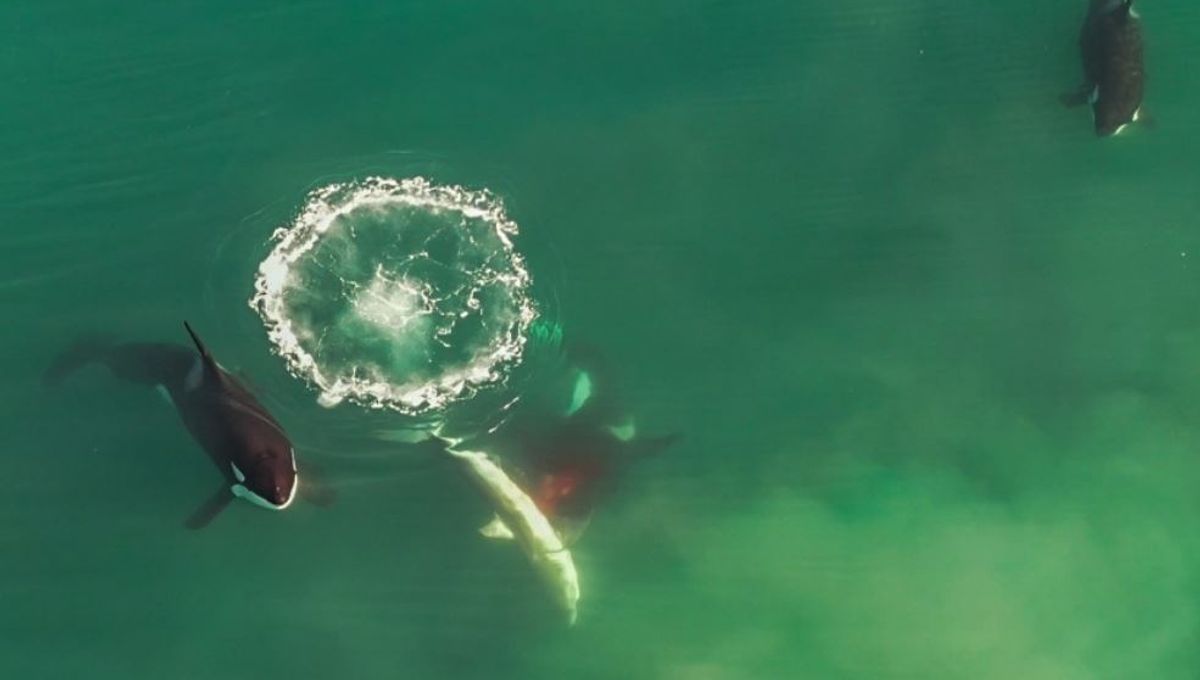
Earlier this year, researchers in South Africa observed killer whales hunting great white sharks for the first time, and new footage of the chase reveals that more orcas are involved than previously thought. Released as part of a new study describing the predation event, the gnarly video shows five killer whales getting in on the act, leading scientists to suspect that the behavior may be spreading through cultural transmission.
The incredible footage, first released as part of Discovery’s Shark Week, was captured on May 16 by study author Christiaan Stopforth, who launched a drone from Hartenbos Beach and river mouth in Mossel Bay. At the same time, a helicopter pilot conducted a series of short tourist flights and was able to film some of the interactions between the orcas and the sharks using his cell phone.
Combining these two video sources, the researchers provide the first direct evidence of orcas killing white sharks. “This behavior has never been witnessed in detail before, and certainly never from the air,” said lead author Alison Towner in a statement.
“At least two, possibly three white sharks were killed by a group of killer whales on the 16 May in Mossel Bay over a period of around 71 minutes,” write the study authors. Previously, only two orcas had been linked to the killing of great whites, so it is significant that five individuals were spotted participating in this hunt.
In their study, the researchers explain how the “killer whales cornered, captured, and incapacitated white sharks.” For instance, they describe how, on one occasion, an orca was observed flipping a shark upside down in order to trigger a type of paralysis called “tonic immobility” before biting the abdomen just behind the pectoral fins.
This tactic resulted in the shark’s liver escaping through the wound and floating to the surface, where it was consumed. According to the study authors, a single adult white shark liver roughly satisfies the daily energy demands of a full-sized male orca, so it’s telling that shark carcasses have previously been found with bite marks around the pectoral fins and missing livers.
The researchers also describe how the sharks attempted to evade predation by tightly circling the orcas and keeping them within view. Such a strategy is often employed by seals and turtles to avoid being eaten by sharks, but may not be effective in this instance due to the fact that killer whales hunt in packs.
Great white sharks are a famously reliable presence in Mossel Bay, yet were conspicuous by their absence in the weeks following the attack as they chose to give the area a wide berth. Commercial shark cage diving operators reported no sightings for 45 days after the event, and didn’t come across another shark until July 1.
“The sharks ultimately abandoned former key habitats, which has had significant knock-on effects for both the ecosystem and shark-related tourism,” explained study author Alison Kock.
After analyzing the footage, the researchers conclude that “more killer whales are hunting white sharks in South Africa than just the two previously identified.”
“If cultural transmission between killer whales is occurring it will have wider reaching impacts on shark populations and will need to be considered in future studies,” they say.
The study was published in the journal Ecology.
Source Link: Watch World-First Footage Of Orcas Making A Snack Out Of Great White Sharks